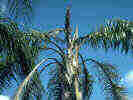
Queen
Palm Care
Queen palms
(Syagrus romanzoffiana) have
been used for many years in the Phoenix metro area for quick shade, screening
and the lush tropical accent they add to any landscape.
They grace gardens across the valley, from older historic districts and
resorts, to new homes being built all around the city.
Although Queen palms are used in a variety of landscape designs, they
tend to be happier in partial or full tropical landscapes as this usually
assures that they will receive the amount of water and fertilize they require
for optimum health.
Queen palms are
native to the South American woodlands of Brazil and Argentina; they are
regarded as a tropical palm rather than a desert palm, (i.e. Mexican and
California fan palms.) Together
with Pygmy Date, Cuban Royal, Triangle and other palms from more tropical areas,
queens require regular feeding with palm food to insure maximum health and
beauty. A well-formulated palm
fertilizer should contain all the minerals important to the health of tropical
palms. This includes adequate amounts of nitrogen, magnesium, sulfur, iron,
copper and especially manganese.
There
has never been a documented case of bud rot in Queen Palms!
Maricopa
County Cooperative Extension Report on Bud Rot
After several years in the
landscape Queen palms are
susceptible to a manganese deficiency problem known as “frizzle top.”
This condition is recognized by the “frizzled” look of new leaves as
they emerge from the crown, or heart, of the palm. The
affected leaves appear stunted and blackened.
If this condition is left untreated the palm tree continues to weaken and
will eventually die. The common believe that a heart rot fungus
(Phytophora) affects Queens is false. A
study by the Arizona Department of Agriculture determined that in 10,000 cases
of "frizzle top" a fungus was present in only 2. By feeding your
Queen palms regularly you can avoid this problem.
 New frond with "Frizzle top" symptoms
New frond with "Frizzle top" symptoms
Click to enlarge
If
it occurs increase the amount of manganese by using fertilizer spikes or
manganese sulfate. Use the powdered form in the ground around the trunk and, if
possible, as a slurry in the crown of the palm.
One of the best ways to insure
your palms have sufficient minerals is to feed with Lutz palm tree fertilizer
spikes 2 to 3 times per year. Palm
spikes are formulated for a slow application of nutrients over a period of
several months and should be placed around the palm tree 18 to 24 inches from
the trunk, 2 to 4 inches below soil level.
Lutz maintenance spikes are used for regular feeding but may be combined
with Lutz manganese spikes to treat a “frizzle top” condition.
A quicker response is obtained using a granular palm food such as
“Plant Magic palm food”. Granular foods should be applied every 3 months in 4 to 6
inch holes placed about 18 to 24 inches from the trunk of the palm.
As with palm spikes, the irrigation emitters should be placed away from
the trunk so that they are approximately over the fertilizer that was applied.
Along with proper feeding,
correct watering is critical for healthy Queen palms (and other tropical
palms!) As a rule of thumb, newly
planted palms should be watered about 3 times a week for the first summer, and a
minimum of twice a week in winter. Sufficient
water to moisten the entire root ball, and 6” into the surrounding soil, is
the correct amount to use each watering period.
Queen palms that have been
planted for 3 to 5 years or more may sometimes not respond to these treatments
if the surrounding soil ph has become excessively high. The heavy clay soils in Maricopa County are typically
alkaline but may become excessively so when lime leaches from surrounding
concrete, such as walkways, house foundations and walls. Periodic applications
of acid to the surrounding soil will lower the ph and allow the palm’s roots
to chemically bind with nutrients allowing them to feed the palm. A commercial soil acidifier may be used or a solution of 1
cup muriatic acid (pool acid) in 5 gallons of water. Depending on the palm’s size the recommended
application rate is 2 to 4 five gallon buckets of solution to treat the entire
root ball area. A substantial
watering 24 hours before will insure against burning and prepare the palm for
treatment.
By following these guidelines
your Queen palms will stay healthy and continue to grace your yard for many more
years.

queen palm
health phoenix Arizona Queen palm health phoenix Arizona
Queen palm
health phoenix Arizona Queen palm health phoenix Arizona
